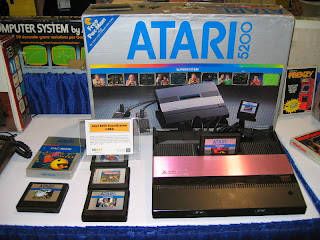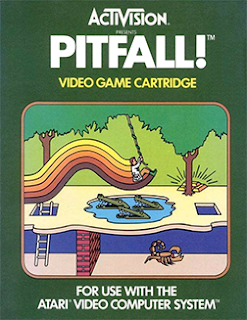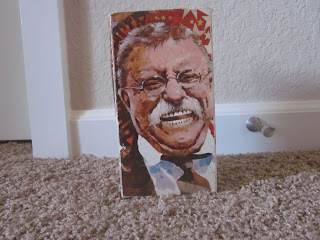We return to our regularly schedule pseudo-review thingamajig... Jiggy.. Jiggy wit it. Sorry, I have no idea what just came over me. I think I was invoking a bit of Fresh Prince, but came up a mile short.
Well, after returning to the game, I found myself back in front of the king, trying to explain exactly why I hadn't saved his daughter yet. I was lucky that I blamed it on a literal lack of experience, but in reality, I just get off on the idea of watching a dragon keep a princess captive.
(Un)fortunately, I needed to get on with the hero saving the princess action. Though I had to do the greatest thing in any RPG ever created EVAR: Grinding. -_- For those who really don't know what that is (and I both pity and am jealous of you) it's when you sit back for a long time fighting random encounters to increase your character/s' level. This process can take a long, long,
loooooooooong time. Luckily for me, I had plenty of time.
After spending a bit of time fighting random creatures, this sign came up. Look at the experience points, 2011. I swear it's an omen. Now that I think about it... How far off was 2001: A Space Odyssey? We're 10 years ahead of that and look at us! No Hal 9000. Not even a T-1000.
Of course, by this point, I was starting to become too strong for a number of the creatures in the area that I felt comfortable working on up. This caused them to run away often...
Usually in a row. This was right after the previous picture...
Damn it, you cock! Seriously, I ran into that guy three times in a row and each time he ran away before I was ready. My agility is higher than his, this is balls! BALLS I SAY!
I ended up deciding to head down to Rimuldar, which is a semi-important town to visit. I wasn't terribly under leveled, but it wasn't going to be easy. The cave down to Rimuldar is very, very straight forward. So much so that I can actually navigate it without sound or being able to see a single square beyond my character. It's down for a long time, right, down, right, down, left...
...God, I feel sickened with myself.
I never really questioned it when I was a kid... But how in the hell did scorpions and, what I'm guessing is tin or iron, mate and produce that? Where does this fit in the evolutionary process? I wonder how much I can scrap them for...
Then again, why am I questioning the logic behind a metal scorpion? The game has wolves wearing a tunic and leather boots... Not to mention learned how to walk on two feet and apparently discovered steroids. Needless to say, if I saw one walking towards me... I'd probably cry.
At approximately $1,600 an ounce... I wonder how much that guy is worth? Maybe this whole "metal evolving into living creatures" thing isn't so horrible. Unless this guy's fool's gold. Then he can go screw himself.
I've always wanted a private island in the middle of a village. That guy looks so cool and he tells us a great story about Erdrick and... Wait... Erdrick created a
rainbow?
...Gayyyyyyy.
For make sexy good times, yes?
This is Orwick. I remember seeing him when I was a kid and, for a while, didn't know you could talk to him. Actually, I thought it was a her for the longest time and felt funny thinking about "her" waiting for "her" girlfriend.
So the poor bloke has been sitting around waiting for his girlfriend. Where is she during all of this?...
Literally on the other side of town. Why in the HELL would Orwick have you meet him there? Especially if you two are supposedly going out to eat. No, you idiot, you sit there and starve. Hope you go to Hell.
The largest building in town is... Actually pretty damn useless in the grand scheme of things. Though it does tell you where to go next. To the south it is! Though that person next to me looks pretty interested in this conversation.
...Okay, so I need to go south, but if I do, I'll be mauled? What type of adventure is this?! I should've stuck with the Adventures of Lolo. Also, doesn't that sound a
little bit like something a villain in Scooby Doo would've said?
So this entire time, I've kinda kept this building under wraps. What's suppose to be in there and who designed this town? Why would you want to make it so the only way in to you building was to either make an unnecessarily long trip around the perimeter of the town or risk fording a moat and drowning in it... Or catching Dysentery?
Underneath the menu is a bridge leading in.
Magic keys! And they unlock
any door! YES! I can now sneak into secret areas that are always locked. Like... Forest Service Road Gates? And uhm... Valhalla? Meh, I'd probably just sneak into businesses after they close and steal crap, or spy on people. These keys unlock
any door, so I can go wherever, really.
Also it's dawned on me that the game capitalizes GOLD like some old timey western prospector.
So I finally get tired of screwing around in town and head south to the magic temple. Entering it after fighting actually fairly hard monsters, I expect a hero's welcome. Instead, this dick is in there and kicks me out. Ass.
After buying better equipment and gaining a level, I decide that I'm strong enough to save Gwaelin. Now, the princess is actually being held captive in the cave that I took without really being able to see where I was going. Seriously, it's that simple. Though I suck and don't know how to get to the princess without light.
In keeping with its historical accuracy, Dragon Warrior makes sure to use a Green Dragon as the villain keeping the princess captive. It's not really talked about in most history books, but whenever a princess goes missing, a dragon is to blame. It's honestly going to be behind a dragon that we'll find Anastasia.
Oh yeah, this goon laid the smack down on me a bit before I put him to sleep and he stayed asleep as I wailed on him.
Once you beat the dragon, you're able to get to the princess... Provided you have a damn Magic Key. By the way, I should mention, you need to have one before leaving Rimuldar to save Gwaelin.
And my how the princess looks... Sick? Wow, she looks dead to me. I guess being trapped in a cell for God knows how long can leave you looking ill. That, or she's actually being quarantined to prevent the spread of the Black Death. Oh well, time to bring her home!
No bitch, you're walking.
After saving her, she jumps into your arms to spread the plague to you. Oh well, you can at least use her as a meat shield, or a weapon of some sort. Imagine grabbing her by the ankles and swinging her at your enemies. They may be monsters, but they'll think twice about screwing with you when you come barreling at them swinging a member of your own species as a weapon.
Unless you have an item called Wings or something like that, or the spell Return, you're in for a LOOOOONG walk home with princess plague weighing you down. But eventually you'll make it back to Tantegel Castle. And with the princess in your arms, you're sure to be hailed as a hero.
...Except you're not. Either these are the most serious guards in the world, or they're just dicks who honestly don't give a shit about their princess. Whatever, I'm sure that guy just around the corner who was looking for the princess (by doing nothing) will be elated to see her!
...What a dick. At least King Lorik is glad to see his daughter home safely. A job well done! And what does Gwaelin have for you? Gold? Gems? Her virginity? That's unlikely, she was defiled by the dragon more than once.
A question. This heinous bitch, who you just busted your ass trying to save, asks you whether you love her or not. So, of course, after this, you say "no." The problem here is that she
refuses to let you say no. So yeah, she's definitely a princess.
This is one of the better known parts of the game as you can keep breaking her heart for hours on end, but her undying optimism (read: spoiled bratty nature) keeps her from accepting anything you say as truth. She's a princess, whatever reality she wants is the reality we all live in.
Trust me, it's just easier to lie to her than anything else. It gets her to shut up and when you stomp on her heart later, it'll be
oh so sweet.
So now Princess Gwaelin is home safe now, but your adventure isn't quite over yet. There's many mysteries for you to find solutions to and there's the whole "Dragonlord" menace that's causing so much shit in your home land. There's still plenty of game left (eh, not really, it's short) to go through, so make sure you return for exciting Part III of this review-type-thing.
One last note, just because I felt bad for him. I ended up talking to Croaky McDeathmiser in Brecconary village after saving the princess... You know, just to rub it in that
I saved the princess whereas he failed and barely made it home to his family alive.
That's when I found out he'd gone deaf and blind. Oh well, that didn't stop me from pushing him over and rubbing my victory into him. I'll let you figure out how I did that.
































































